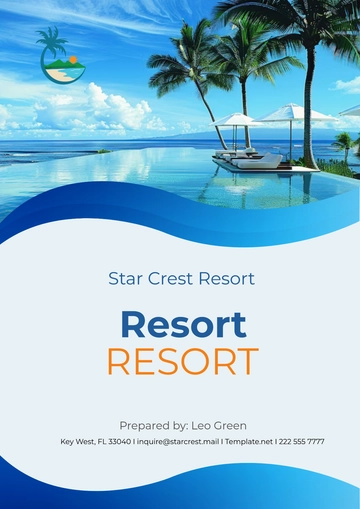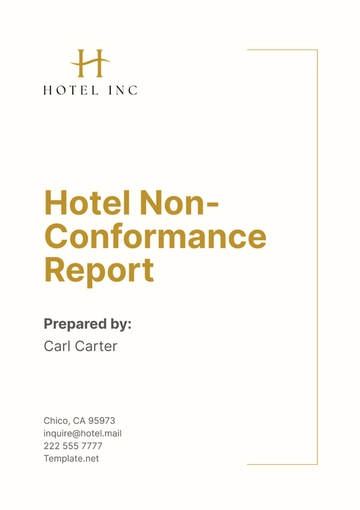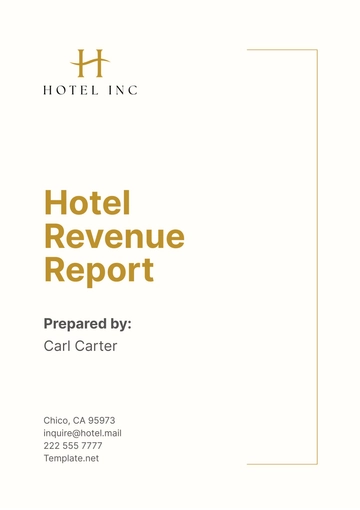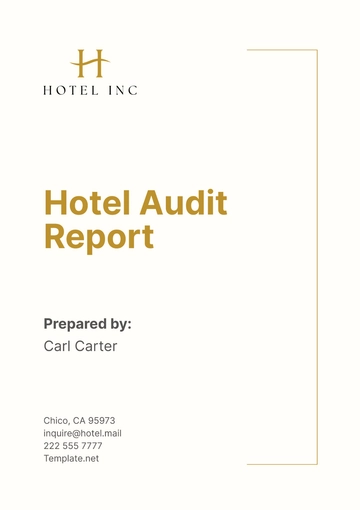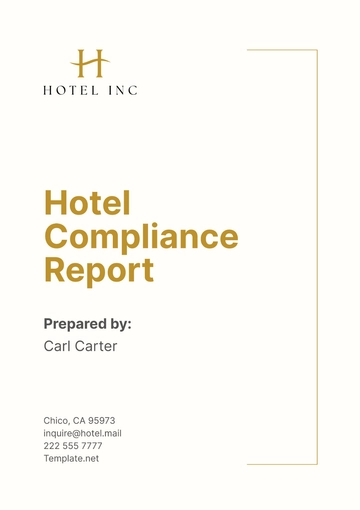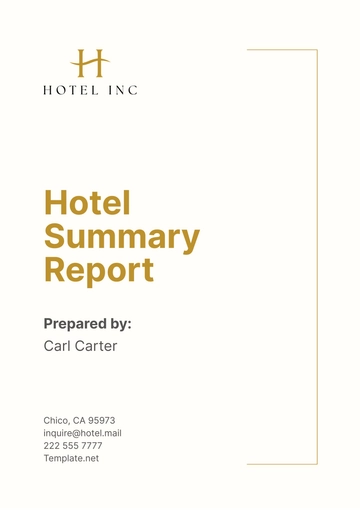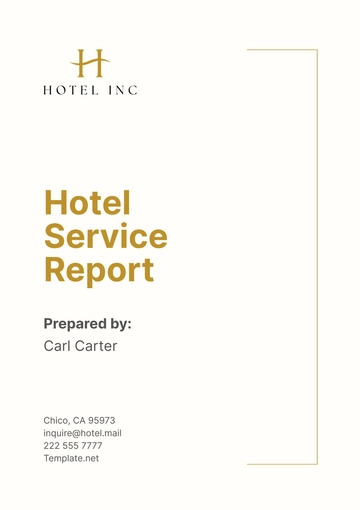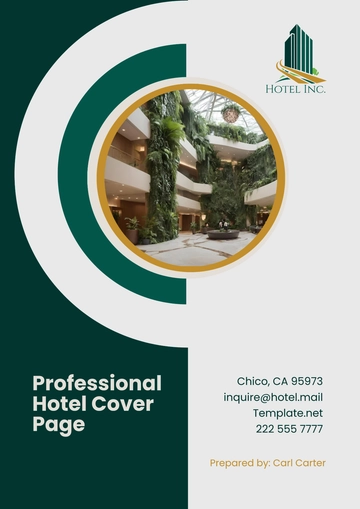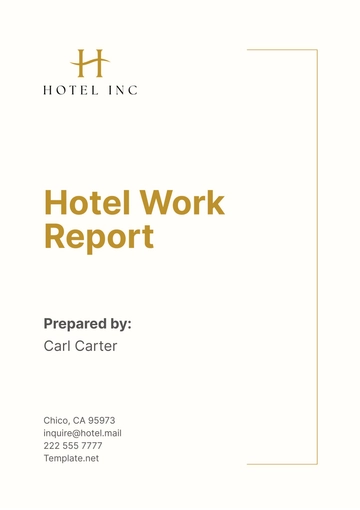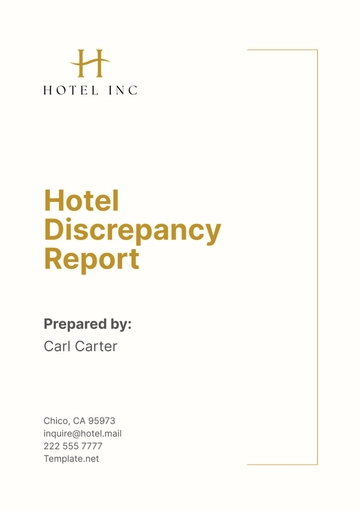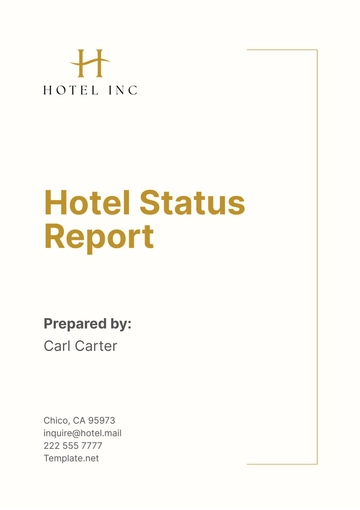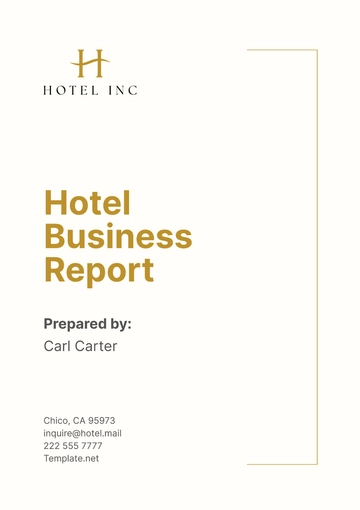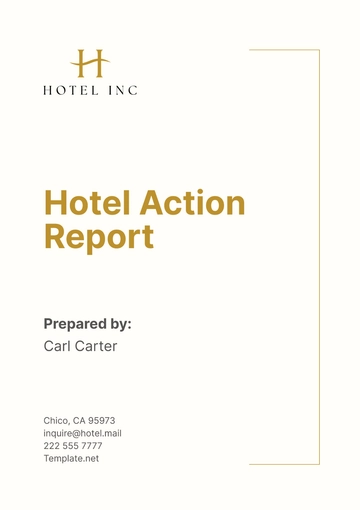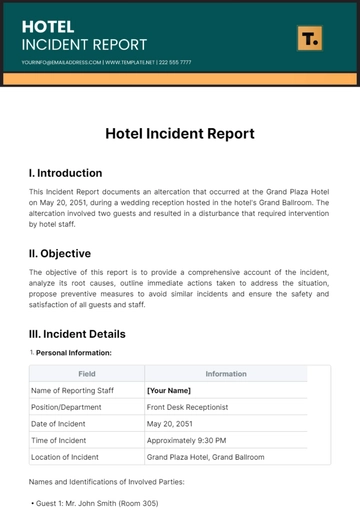Free Hotel Revenue Report
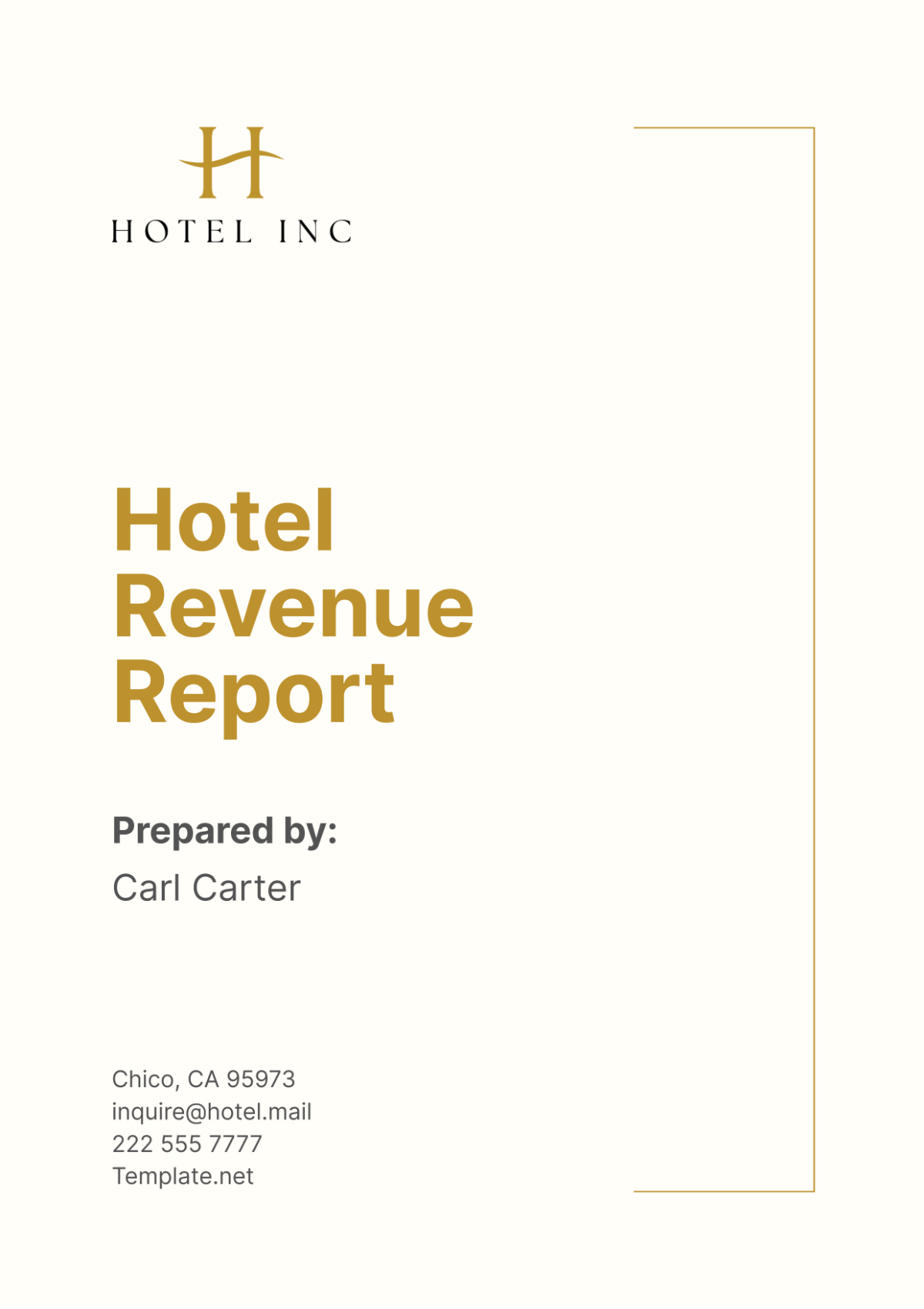
I. Executive Summary
A. Introduction
The Executive Summary provides a succinct overview of [Your Company Name]'s performance over the specified period. This section encapsulates the hotel's financial metrics, major achievements, and challenges encountered. It aims to present stakeholders with a quick, comprehensive snapshot of the hotel’s financial health and operational highlights. The report covers all essential aspects of revenue, expenditure, and profit, while also discussing key factors that have influenced performance, both positively and negatively. Through this summary, stakeholders can grasp the overall business scenario at a glance, setting the context for a more detailed analysis that follows.
B. Key Findings
Total Revenue: The hotel generated a total revenue of [$5,450,000] for the quarter, which represents a significant [10%] increase compared to the previous quarter. This growth can be attributed to various factors including higher occupancy rates, increased room rates, and successful promotional activities.
Occupancy Rate: The average occupancy rate stood at [75%], reflecting a [5%] year-over-year improvement. This increase highlights the hotel's ability to attract more guests and maintain high levels of occupancy even during off-peak seasons.
Average Daily Rate (ADR): The ADR increased to [$250], up from [$230] in the same period last year. This rise in ADR demonstrates the hotel's success in enhancing its perceived value and pricing strategies without negatively impacting occupancy.
Revenue per Available Room (RevPAR): The RevPAR reached [$187.50], marking a [7%] rise from the previous quarter. This metric combines both the occupancy rate and ADR, providing a comprehensive measure of the hotel's revenue performance.
Net Profit: The hotel achieved a net profit of [$1,200,000], which is a [15%] increase over the previous period. This impressive growth in net profit reflects the hotel’s efficient cost management and successful revenue generation strategies.
C. Major Highlights
Expansion and Renovation: The completion of the new wing added [50] rooms, contributing to the increase in occupancy and revenue. This expansion not only provides more capacity to accommodate guests but also offers modern, upgraded facilities that enhance the overall guest experience.
Marketing Campaigns: Successful digital marketing campaigns targeting international tourists led to a significant increase in bookings. These campaigns utilized social media, search engine optimization, and targeted online ads to reach potential guests from key markets around the world.
Guest Satisfaction: The hotel's guest satisfaction score improved by [8%], reaching an average rating of [4.5] out of [5]. This improvement is the result of continuous efforts to enhance service quality, facilities, and overall guest experience. Regular training programs for staff and the implementation of guest feedback have played a crucial role in achieving these high satisfaction levels.
II. Financial Analysis
A. Revenue Breakdown
Room Revenue: Room revenue amounted to [$3,800,000], accounting for [70%] of the total revenue. This significant portion of revenue underscores the importance of maintaining high occupancy rates and optimizing room rates.
Food and Beverage Revenue: The hotel's restaurants and bars generated [$1,200,000] in revenue, representing [22%] of the total. This revenue segment reflects the hotel's ability to attract not only staying guests but also local diners and event attendees.
Other Revenue: Additional services such as spa, conference facilities, and gift shop sales contributed [$450,000], making up [8%] of the total revenue. Diversifying revenue streams through these ancillary services helps the hotel mitigate risks associated with fluctuations in room occupancy.
Table 1: Revenue Breakdown
Revenue Source | Amount ($) | Percentage (%) |
|---|---|---|
Room Revenue | 3,800,000 | 70 |
Food and Beverage | 1,200,000 | 22 |
Other Revenue | 450,000 | 8 |
Total | 5,450,000 | 100 |
B. Expense Analysis
Operational Expenses: The total operational expenses for the quarter were [$2,500,000]. These expenses include utilities, supplies, and general upkeep necessary for the hotel's daily operations.
Labor Costs: Employee wages and benefits amounted to [$1,200,000], highlighting the importance of investing in a skilled and motivated workforce. Labor costs are a major component of total expenses, reflecting the hotel's commitment to maintaining high service standards.
Marketing Expenses: The hotel spent [$300,000] on marketing and promotional activities. These expenses cover a wide range of marketing efforts, from digital campaigns and print advertisements to partnerships with travel agencies.
Maintenance Costs: Maintenance and repairs costs were [$200,000], ensuring that the hotel's facilities remain in top condition. Regular maintenance is crucial for preventing larger, more costly issues and ensuring guest satisfaction.
Table 2: Expense Breakdown
Expense Category | Amount ($) |
|---|---|
Operational Expenses | 2,500,000 |
Labor Costs | 1,200,000 |
Marketing Expenses | 300,000 |
Maintenance Costs | 200,000 |
Total | 4,200,000 |
C. Profit and Loss Statement
Table 3: Profit and Loss Statement
Financial Metric | Amount ($) |
|---|---|
Total Revenue | 5,450,000 |
Total Expenses | 4,200,000 |
Net Profit | 1,200,000 |
The Profit and Loss Statement provides a clear picture of the hotel’s financial performance, highlighting the balance between revenue and expenses. With total revenue surpassing total expenses by a substantial margin, the hotel has demonstrated robust profitability.
III. Operational Performance
A. Occupancy Analysis
Average Occupancy Rate: The average occupancy rate was [75%], indicating strong demand for the hotel’s rooms throughout the period. Maintaining high occupancy rates is critical for maximizing revenue and ensuring the efficient use of hotel resources.
Peak Occupancy: Peak occupancy reached [90%] during major local events, showcasing the hotel's ability to capitalize on periods of high demand. These events often attract a significant number of guests, providing an opportunity for the hotel to increase its rates and maximize revenue.
Low Season Occupancy: The lowest occupancy rate recorded was [60%], which typically occurs during off-peak seasons. Despite the seasonal fluctuations, the hotel managed to maintain a reasonable occupancy rate through targeted promotions and discounts.
B. Room Type Performance
Standard Rooms: Standard rooms had an occupancy rate of [80%] with an ADR of [$200]. These rooms are the most popular among guests, offering a balance of comfort and affordability.
Deluxe Rooms: Deluxe rooms saw an occupancy rate of [70%] with an ADR of [$300]. These rooms cater to guests seeking a higher level of comfort and amenities.
Suites: Suites had an occupancy rate of [60%] with an ADR of [$500]. These premium accommodations are favored by guests looking for luxury and exclusivity.
Table 4: Room Type Performance
Room Type | Occupancy Rate (%) | ADR ($) |
|---|---|---|
Standard Rooms | 80 | 200 |
Deluxe Rooms | 70 | 300 |
Suites | 60 | 500 |
C. Food and Beverage Performance
Restaurant Revenue: The main restaurant generated [$800,000] in revenue with an average spend per guest of [$50]. The restaurant's popularity is driven by its high-quality cuisine and exceptional service, attracting both hotel guests and local patrons.
Bar Revenue: The bar generated [$300,000] in revenue with an average spend per guest of [$30]. The bar offers a variety of beverages and a vibrant atmosphere, making it a popular choice for social gatherings.
Banquets and Events: Banquet and event services brought in [$100,000]. The hotel’s well-equipped facilities and professional event planning services make it a preferred venue for corporate events, weddings, and other special occasions.
Table 5: Food and Beverage Performance
Outlet | Revenue ($) | Average Spend per Guest ($) |
|---|---|---|
Restaurant | 800,000 | 50 |
Bar | 300,000 | 30 |
Banquets & Events | 100,000 | - |
IV. Market Analysis
A. Competitive Analysis
Market Position: [Your Company Name] is positioned as a premium hotel in the competitive landscape, known for its luxurious accommodations, exceptional service, and prime location. This positioning helps attract a discerning clientele willing to pay a premium for quality.
Key Competitors: Major competitors include Hotel A, Hotel B, and Hotel C. These hotels offer similar amenities and services, making it crucial for [Your Company Name] to continuously innovate and differentiate itself to stay ahead.
Market Share: The hotel holds a [15%] market share in the local luxury hotel segment. Maintaining and growing this market share involves ongoing efforts in marketing, customer service, and facility upgrades.
B. Customer Segmentation
Leisure Travelers: Leisure travelers account for [60%] of bookings. These guests typically seek relaxation and recreation, making the hotel's amenities such as the spa, pool, and restaurants highly attractive.
Business Travelers: Business travelers represent [30%] of bookings. These guests prioritize convenience, connectivity, and professional services, making facilities like the business center, conference rooms, and high-speed internet essential.
Group Bookings: Group bookings make up [10%] of total bookings. These include events such as corporate retreats, weddings, and tour groups, requiring comprehensive planning and coordination to ensure a seamless experience.
C. Marketing and Sales Strategies
Digital Marketing: Investment in online advertising and social media campaigns targeting international tourists has been a key driver of increased bookings. Utilizing platforms like Facebook, Instagram, and Google Ads allows the hotel to reach a broad audience and tailor its messaging to specific demographics.
Partnerships: Collaborations with travel agencies and corporate clients have been instrumental in boosting group bookings. These partnerships involve negotiated rates, exclusive deals, and joint promotional efforts, ensuring a steady flow of guests from reliable sources.
Promotions: Seasonal discounts and loyalty programs are designed to attract repeat customers and incentivize new bookings. These promotions include special offers for holidays, loyalty points for frequent stays, and bundled packages that provide added value.
V. Guest Experience
A. Guest Satisfaction Metrics
Overall Satisfaction Score: The hotel achieved an average satisfaction score of [4.5] out of [5], reflecting high levels of guest contentment. This score is derived from various feedback channels, including online reviews, direct guest surveys, and third-party evaluations.
Service Quality: Rated [4.6] with positive feedback on staff friendliness and professionalism. Exceptional service quality is a cornerstone of the hotel's reputation, with staff training and development programs playing a key role in maintaining high standards.
Cleanliness: Rated [4.8] with high marks for room and facility cleanliness. Ensuring a clean and hygienic environment is essential for guest comfort and safety, particularly in the current health-conscious climate.
B. Feedback and Reviews
Positive Feedback: Guests praised the spacious rooms, excellent food, and courteous staff. Specific compliments often highlight the attentiveness of the staff, the quality of the dining experience, and the comfort of the accommodations.
Negative Feedback: Some complaints were noted regarding the slow check-in process and limited parking space. Addressing these issues promptly is crucial for maintaining high satisfaction levels and preventing negative reviews from impacting the hotel’s reputation.
Action Plans: Initiatives to address negative feedback include upgrading the check-in system to streamline the process and expanding parking facilities to accommodate more guests. Continuous improvement based on guest feedback ensures that the hotel remains responsive to guest needs and expectations.
VI. Strategic Initiatives
A. Future Investments
Technology Upgrades: Plans to invest in advanced booking systems and in-room technology enhancements are underway. These upgrades aim to provide a seamless and modern experience for guests, from booking to check-out, and to enhance operational efficiency.
Facility Improvements: Renovation of older rooms and expansion of the fitness center and spa facilities are planned to ensure the hotel remains competitive and appealing. Modern, well-maintained facilities attract discerning guests and enhance their overall experience.
Sustainability Initiatives: Implementation of eco-friendly practices such as energy-efficient lighting, water-saving fixtures, and waste reduction programs are part of the hotel’s commitment to sustainability. These initiatives not only appeal to environmentally conscious guests but also reduce operational costs.
B. Market Expansion
New Market Segments: Targeting new demographics such as millennials and eco-conscious travelers involves tailoring marketing efforts and services to appeal to these groups. Offering unique experiences, sustainable practices, and leveraging social media influencers are some strategies employed.
Geographic Expansion: Exploring opportunities to open new branches in emerging tourist destinations can help diversify the hotel's portfolio and tap into new markets. Strategic locations with growing tourism potential are identified for expansion.
Service Diversification: Adding new services such as wellness retreats, culinary tours, and adventure packages helps attract diverse clientele. These offerings cater to the varied interests of guests and provide additional revenue streams.
VII. Conclusion
A. Summary of Performance
[Your Company Name] has demonstrated robust financial performance and operational efficiency in the past quarter. The hotel has successfully increased its revenue, improved guest satisfaction, and maintained a competitive edge in the market. Key metrics such as revenue growth, occupancy rate, ADR, and guest satisfaction scores underscore the hotel's strong position.
B. Recommendations
Enhance Digital Presence: Continue to invest in digital marketing strategies to reach a broader audience. Emphasizing online reviews, social media engagement, and targeted advertising will help attract more guests and increase bookings.
Improve Guest Experience: Address areas of improvement based on guest feedback to ensure high satisfaction levels. Regularly updating facilities, providing exceptional service, and responding promptly to guest concerns are essential.
Focus on Sustainability: Strengthen sustainability initiatives to appeal to environmentally conscious guests and reduce operational costs. Implementing green practices and communicating these efforts to guests can enhance the hotel's reputation and attract a loyal customer base.
C. Future Outlook
The outlook for [Your Company Name] remains positive with planned investments and strategic initiatives expected to drive further growth and profitability. The hotel is well-positioned to capitalize on emerging trends and maintain its status as a leading player in the hospitality industry. By continuing to innovate and adapt to changing market dynamics, [Your Company Name] can sustain its success and achieve its long-term objectives.
- 100% Customizable, free editor
- Access 1 Million+ Templates, photo’s & graphics
- Download or share as a template
- Click and replace photos, graphics, text, backgrounds
- Resize, crop, AI write & more
- Access advanced editor
Track and optimize your hotel's revenue streams with the Hotel Revenue Report Template from Template.net. This editable and customizable document provides a structured format for analyzing revenue sources, trends, and forecasts. Seamlessly tailored in our AI Editor Tool, generate detailed reports to maximize revenue generation and growth.
You may also like
- Sales Report
- Daily Report
- Project Report
- Business Report
- Weekly Report
- Incident Report
- Annual Report
- Report Layout
- Report Design
- Progress Report
- Marketing Report
- Company Report
- Monthly Report
- Audit Report
- Status Report
- School Report
- Reports Hr
- Management Report
- Project Status Report
- Handover Report
- Health And Safety Report
- Restaurant Report
- Construction Report
- Research Report
- Evaluation Report
- Investigation Report
- Employee Report
- Advertising Report
- Weekly Status Report
- Project Management Report
- Finance Report
- Service Report
- Technical Report
- Meeting Report
- Quarterly Report
- Inspection Report
- Medical Report
- Test Report
- Summary Report
- Inventory Report
- Valuation Report
- Operations Report
- Payroll Report
- Training Report
- Job Report
- Case Report
- Performance Report
- Board Report
- Internal Audit Report
- Student Report
- Monthly Management Report
- Small Business Report
- Accident Report
- Call Center Report
- Activity Report
- IT and Software Report
- Internship Report
- Visit Report
- Product Report
- Book Report
- Property Report
- Recruitment Report
- University Report
- Event Report
- SEO Report
- Conference Report
- Narrative Report
- Nursing Home Report
- Preschool Report
- Call Report
- Customer Report
- Employee Incident Report
- Accomplishment Report
- Social Media Report
- Work From Home Report
- Security Report
- Damage Report
- Quality Report
- Internal Report
- Nurse Report
- Real Estate Report
- Hotel Report
- Equipment Report
- Credit Report
- Field Report
- Non Profit Report
- Maintenance Report
- News Report
- Survey Report
- Executive Report
- Law Firm Report
- Advertising Agency Report
- Interior Design Report
- Travel Agency Report
- Stock Report
- Salon Report
- Bug Report
- Workplace Report
- Action Report
- Investor Report
- Cleaning Services Report
- Consulting Report
- Freelancer Report
- Site Visit Report
- Trip Report
- Classroom Observation Report
- Vehicle Report
- Final Report
- Software Report
